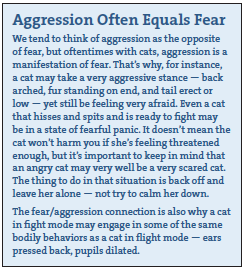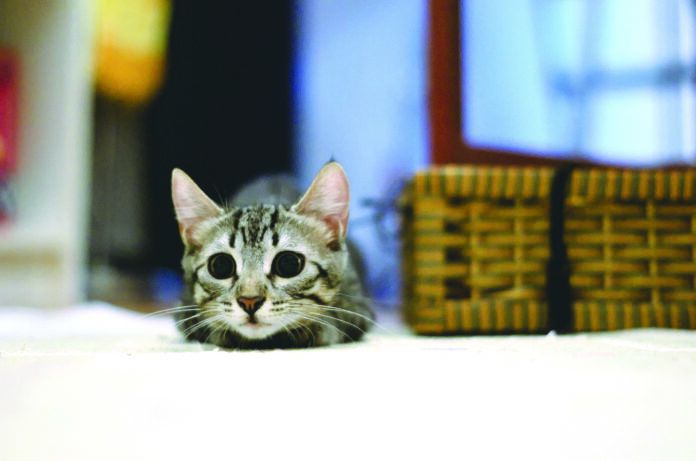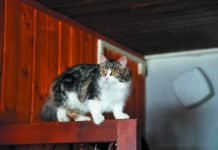“People think hiding is just what cats do,” says the head of the Tufts Animal Behavior Service, Stephanie Borns-Weil, DVM. “But hiding is a sign of fear. Cats that generally avoid contact are afraid.”
There are a number of other signs of fear in a cat that are also easy to misinterpret — or at least overlook. They’re important to learn so that you can be aware of when your cat is in a state of worry about her safety and take steps to mitigate the cause for her trepidation — or at least not make it any worse. Cats and people don’t share a spoken language, but both species are fluent in body language, and everyone can learn the feline version of that language.
Dr. Borns-Weil notes that sometimes you have to look at the context in which the cat is speaking with her body. Certain behaviors are signs of fear only in specific situations.
Falling asleep. Of course, there are many situations in which it is perfectly natural for a cat to fall asleep. But frequently enough when nervousness is running high, like in a veterinary clinic, a cat will half fall asleep, or fall into a kind of sham sleep, while she is being examined and the doctor is touching her face and other parts of her body. “That could be a sign of stress or anxiety,” Dr. Borns-Weil says, especially if the cat folds in on herself. It’s a way of trying to remove herself from the experience she’s having to endure. Without stress, cats tend not to sleep all tucked up, unless perhaps they are feeling cold. And they don’t tend to fall asleep in the middle of something that concerns them.
Crouched body stance. A cat may walk with both her head and her tail down right before she springs on a mouse. But if there’s no prey present and you’re seeing a cat act that way, you’re looking at fear, “at discomfiture,” says Dr. Borns-Weil.
Dilated pupils. If a cat’s pupils dilate and the amount of light in the room has not lessened, she could be feeling anxious.
Ears back. Take a look at the position of your cat’s ears. If she has “pushed” them back, she is afraid.
 Self-grooming. Cats lick themselves clean all the time. But let’s say a visitor comes over to your house and for some reason the cat can’t leave the room; maybe you have inadvertently closed all the doors. If all of a sudden she starts grooming herself intensely, it could be an expression of anxiety about the “interloper.” Think of it the way you might react to having to stop at a red light when you’re in a hurry. You want to get moving but can’t, so you fiddle with the mirror or the radio dial — it’s a way of trying to deal with the fact that you’re stuck. Same with a cat who all of a sudden is intent on furiously licking herself in the face of an unexpected turn of events that she can’t escape.
Self-grooming. Cats lick themselves clean all the time. But let’s say a visitor comes over to your house and for some reason the cat can’t leave the room; maybe you have inadvertently closed all the doors. If all of a sudden she starts grooming herself intensely, it could be an expression of anxiety about the “interloper.” Think of it the way you might react to having to stop at a red light when you’re in a hurry. You want to get moving but can’t, so you fiddle with the mirror or the radio dial — it’s a way of trying to deal with the fact that you’re stuck. Same with a cat who all of a sudden is intent on furiously licking herself in the face of an unexpected turn of events that she can’t escape.
Tail tucked under. A cat who tucks her tail under her body doesn’t just happen to be hanging out that way. It means she is feeling submissive, trying not to invite trouble in a situation that is making her frightened.
Lowered head, with whiskers pulled back. This means the cat is trying to appear small and non-threatening.




